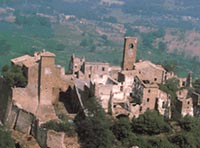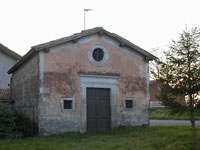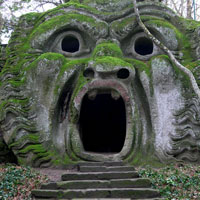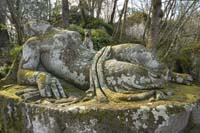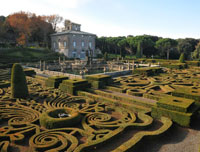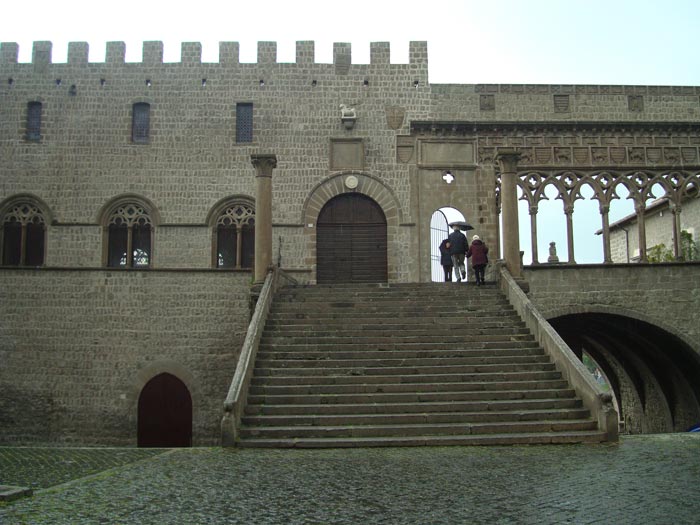 |
|
Viterbo |
|
Viterbo |
| Viterbo is surrounded by the Monti Cimini and Monti Volsini. The historic center of the city is surrounded by medieval walls, still intact, built during the 11th and 12th centuries.
Viterbo's historic center is one of the best preserved medieval towns of central Italy. Many of the older buildings (particularly churches) are built on top of ancient ruins, recognizable by their large stones, 50 centimeters to a side. The main attraction of Viterbo is the Palazzo dei Papi, that served as a country residence and a repair in time of trouble in Rome. Begun as the Episcopal Palace in 1255, from 1257 on, with the arrival of Alexander IV the works were hurried and were completed in 1267 with the construction of the famous loggia, which in origin was a double one, but then the northern part collapsed under the excessive weight and has not been rebuilt ever since. The columns of the palace are spolia from a Roman temple. At the right of the Loggia begins the proper Episcopal Palace with the Sala Gualtiero(Throne Hall), the Gallery, the Library Hall, the Hall of Arms and the Appartment of the Cardinal. The second most important monument of the city is the Cathedral of S. Lorenzo. It was erected in Romanesque style by Lombard architects over a temple of Hercules. It was variously rebuilt from the sixteenth century on, and was heavily damaged in 1944 by Allied bombs. The notable Gothic belfry is from the first half of the fourteenth century, and shows influence of Senese artists. The church houses the sarcophagus of Pope John XXI and the picture Christ Blessing by Gerolamo da Cremona (1472). Built originally in Romanesque forms, it has been modified in the subsequent centuries. The actual front dates back to 1570, while the Gothic -Tuscan campanile with its four rows of double double-windows dates back to 1368. The three-aisled interior with the columns with magnificent capitals and the finely decorated beamed ceiling is very airy. In the nave you find the rests of a Cosmatesque pavement. In the right aisle there is a marble font of 1470 by Maestro Francesco di Ancona. In the apse of the left aisle, you find a painting of Byzantine school of approx. 1195 representing the Madonna della Carbonara, taken from the homonymous Mother Church of the Knights of the Order of Saint-John-of-Jerusalem, and remains of frescoes of 1290. Past the entrance to the Baroque furnished sacristy, there is a painting ascribed to the Mantegna("Il Salvatore", 1472) and towards the exit, remains of 14th century frescoes and the tomb of John XXI, died tragically in Viterbo in 1277 and mentioned by Dante in his Paradise. John XXI has been by the way the only Portuguese Pope in history. The Museo Civico (City Museum) houses many archeological specimens from the pre-historical to Roman times, plus a Pinacoteca (gallery) with paintings of Sebastiano del Piombo, Antoniazzo Romano, Salvator Rosa, Antiveduto Grammatica and others. |
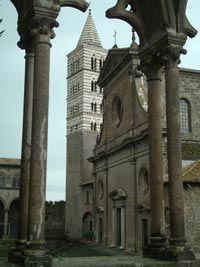 Cathedral of San Lorenzo Cathedral of San Lorenzo |
|
| Just outside the city center of Viterbo there are the famous Thermal Baths of the Popes and the spring of "Bullicame", mentioned in canto XIV in Dante's Inferno, which feeds the big swimming pool of the "Terme dei Papi" and various other "pools". Other springs in the nearby, all belonging to the basin of the "Bullicame" flow other "pools" scattered in the surrounding countryside. In the immediate vicinity of Viterbo there is the Etruscan necropolis of Castel d'Asso and only nine kilometers far the ruins of the "civitas splendidissima" of Ferento with its Roman theatre. Ferento was destroyed by the rival Viterbese in the 1100s. Not much remains except the well preserved theater and the foundations of some Roman baths. This hilltop, which once held an Etruscan and then wealthy Roman city, was reduced to rubble. Performances and concerts are still held in the amphitheatre. Ferento can be reached following Viterbo-Bagnoregio provincial road, turning at km 7. |
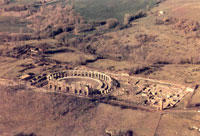 |
|
Celleno is located in the eastern part of the Tuscia area of Viterbo. The old village lays on a 476-metres-high green hill on which you can notice a fascinating medieval castle, Castello Orsini. Also in Celleno you can visit the medieval abbey and church rich in artistic masterpieces. The old hamlet is by now uninhabited and it is located on the top of the hill, a little far from the new Celleno. The old hamlet consists mainly of small red tuff houses, without plaster, for the most part in ruins, because they were abandoned after the disastrous earthquakes that caused great damage to the village. Some finds testify the presence of the first settlements dating back to the 13th century B.C., but probably the area was already inhabited in the Neolitic age as it is proved by the finding of stone weapons dating back to that period. Celleno is located in a strategic position and being on the road for Viterbo , it was invaded by the Romans that seized it in 264 B.C. throwing the Etruscans out. Later it was attacked and sacked by the Goths, the Longobards and the Byzantines. The little church of San Rocco holds several eighteenth-century canvases (Our Lady of the Rosary and a Crucifixion) and a fifteenth century wooden crucifix. Castle Orsini Among the numerous attractions are the ruins of a medieval castle Orsini, and annual celebrations of the Cherries Festival called Festa delle Ciliegie and the Crucifix Day. The name Celleno comes from a Latin Word cella – a cell, which means a hollow. In a number of documents and also in the frescos of the geographical map halls of the Vatican Museum the town appears as Celleum. Unlike the historical centre, the imposing building seems to have passed unharmed through the terrible telluric shocks that have threatened the hamlet several times and it shows its majestic grandeur. East of Celleno are Grotte Santo Stefano and Castello di Montecalvello. |
||
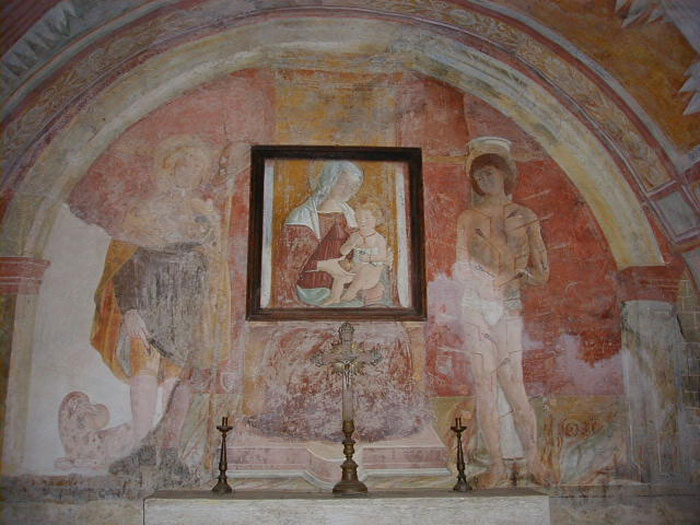 |
||
Fresco in the chiesetta di Santa Maria di Montecalvello |
||
| Bomarzo is a small town, located near Viterbo on the road to Orta. It is the Orsini family's hereditary fief. The Castle rises at the edge of this small town. The residence's gardens were created by Vicino Orsini, the Duke of Bomarzo. He was born in 1528 and died in 1588. An educated humanist, he was interested in the Arts and was their patron. He devoted his life to the happiness of his House and his wife, Julia Farnese. After Julia Farnese's death, he created the plan for this garden. He didn't call this garden a giardino, but Bosco Sacro, a Sacred Grove or Bosco dei Monstri, the Monsters' grove. Monster must be understood in the Latin meaning of monstrare, which means to show and demonstrate. This then means that from stop to stop, from stage to stage, each element is a component of an immense, very neoplatonic poem to his lost love. To create this garden, he called on one of the greatest landscapers and architects of his time, Pirro Ligorio. All the Italian princes came to visit, as did innumerable foreign travelers. Unfortunately, as with most of the Renaissance gardens, the work was neglected. When it was revisited in the beginning of this century, it was overgrown with trees, everything was half collapsed, all of which merely gave the garden an even more fantastic aspect. It was at this time that André Pieyre de Mandiargue visited and wrote a sublime treatise on the sleeping garden of Bomarzo. Salvador Dali and Cocteau, the surrealists, discussed it at great length. [Source: Fondation Jacques-Edouard Berger | www.bergerfoundation.ch] Gardens in Italy | Il parco dei Mostri di Bomarzo (English) Vanished splendors. A Memoir. By Balthus as told to Alain Vircondelet. Translated by Benjamin Ivry, 237 pp. New York: Ecco/HarperCollinsPublishers. Lazio Nascosto | Borghi, paesi e luoghi incantevoli del Lazio | La città perduta di Celleno - Celleno |
|
|
Villa Lante at Bagnaia is a Mannerist garden of surprise near Viterbo, attributed to Jacopo Barozzi da Vignola.
|
|
|
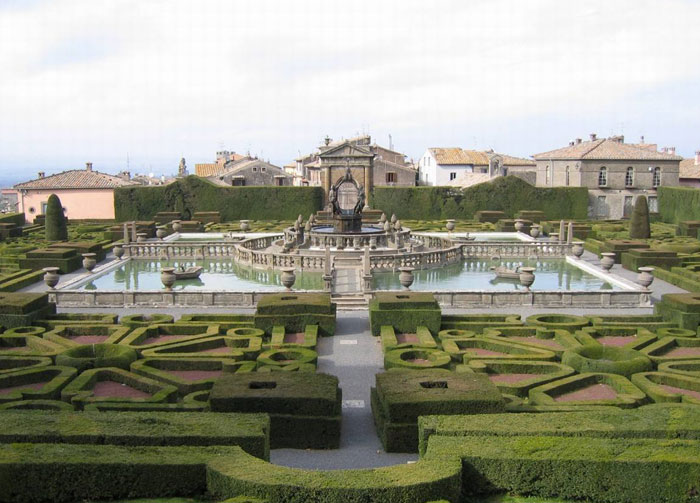 |
||
Villa Lante at Bagnaia
|
||
Hidden secrets in Tuscany | Holiday home Podere Santa Pia
|
||
 |
||
Spectacular panoramic scenery in Podere Santa Pia, with views that stretch all the way to the Mediterranean sea and the islands of Montecristo and Corsica (view from the terrace in November)
|
||
Communities of the Province Viterbo | Acquapendente · Arlena di Castro · Bagnoregio · Barbarano Romano · Bassano Romano · Bassano in Teverina · Blera · Bolsena · Bomarzo · Calcata · Canepina · Canino · Capodimonte · Capranica · Caprarola · Carbognano · Castel Sant'Elia · Castiglione in Teverina · Celleno · Cellere · Civita Castellana · Civitella d'Agliano · Corchiano · Fabrica di Roma · Faleria · Farnese · Gallese · Gradoli · Graffignano · Grotte di Castro · Ischia di Castro · Latera · Lubriano · Marta · Montalto di Castro · Monte Romano · Montefiascone · Monterosi · Nepi · Onano · Oriolo Romano · Orte · Piansano · Proceno · Ronciglione · San Lorenzo Nuovo · Soriano nel Cimino · Sutri · Tarquinia · Tessennano · Tuscania · Valentano · Vallerano · Vasanello · Vejano · Vetralla · Vignanello · Villa San Giovanni in Tuscia · Viterbo · Vitorchiano |
||

